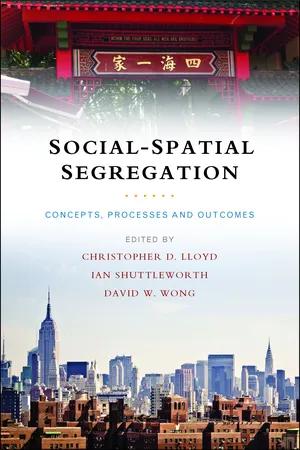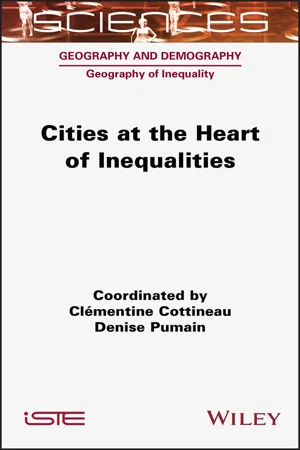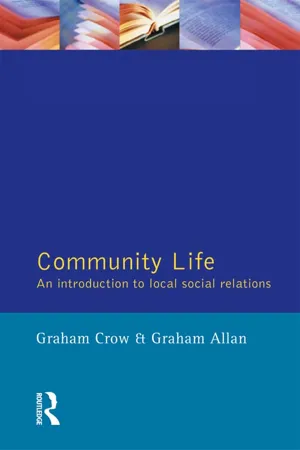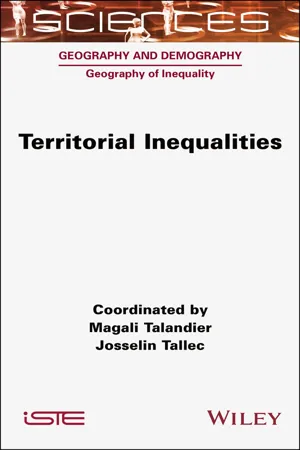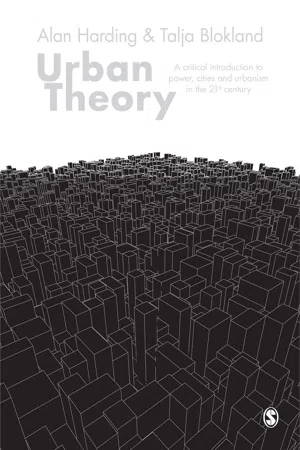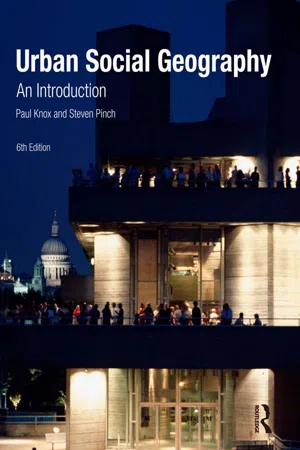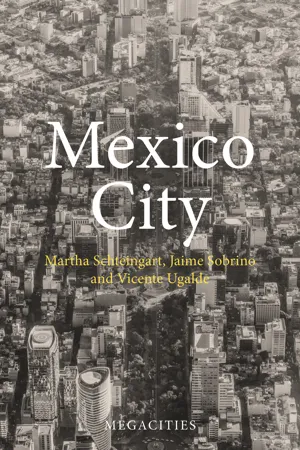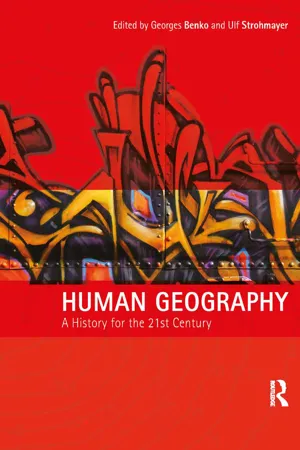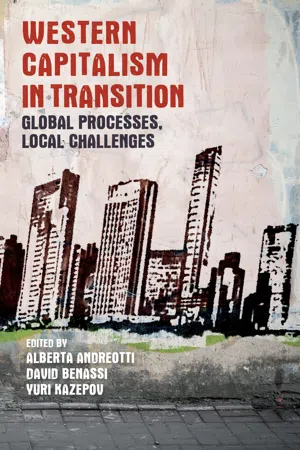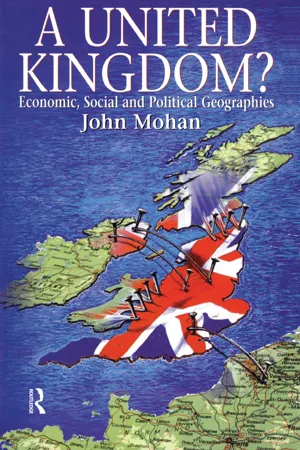Geography
Segregation
Segregation refers to the enforced separation of different racial, ethnic, or social groups within a community or society. This can manifest in various forms, such as residential, educational, or economic segregation, and often results in unequal access to resources and opportunities for marginalized groups. Segregation has significant implications for the spatial organization and social dynamics of a place.
Written by Perlego with AI-assistance
Related key terms
Related key terms
1 of 4
Related key terms
1 of 3
12 Key excerpts on "Segregation"
- eBook - ePub
Urban Sores
On the Interaction between Segregation, Urban Decay and Deprived Neighbourhoods
- Hans Skifter Andersen(Author)
- 2019(Publication Date)
- Routledge(Publisher)
Chapter 2 Social Segregation in CitiesSocial spatial Segregation means that different people are located in different parts of cities. Segregation has been a rather ambiguous concept used in many different contexts. Sometimes it has been used to characterise general differences in the social composition of residents in different urban areas – synonymous with a term such as the social geography of cities. In other contexts, it refers to a spatial concentration of certain social or ethnic groups.More precisely, Segregation can be defined as the interaction between social differentiation and spatial distance (Olsson Hort, 1992; Saltman, 1991; Boal, 1997; Park, 1952). Spatial separation of groups of people should therefore be seen only as Segregation if these groups differ in important social (or ethnic) respects. Most research on Segregation has focused on how it affects the quality of life and social conditions of the groups that are separated. Both positive and negative consequences have been identified – often depending on the extent to which Segregation has been voluntary or enforced (van Kempen and Özükren, 1998).A further condition for using the term ‘spatial social differentiation’ for Segregation may be if it prompts increasing inequality between the separated groups. A more precise definition of social Segregation could then be that Segregation is a spatial separation of ethnic or socially different groups leading to increasing social or cultural differences between these groups.In this book, Segregation is looked at from a special angle. What we are concerned about is the interaction between the economic/physical development of different parts of cities and the distribution of people in space. It could also be called the connection between people and places. More precisely, we focus on how Segregation and urban decay affect each other. - eBook - ePub
Social Geography
Progress and Prospect
- Michael Pacione, Michael Pacione(Authors)
- 2013(Publication Date)
- Routledge(Publisher)
The impact of Segregation on inter-group relations, a topic of considerable practical importance, is then assessed. This is followed by an examination of two concepts 'territory' and 'critical mass' both of which hold considerable promise for the study of Segregation. In conclusion a number of suggestions are made for further research, including and the the study of networks holistic examination and of interaction segregated 'communities'. Definition of Segregation The term Segregation requires definition. The Concise Oxford Dictionary gives 'segregating or being segregated; enforced separation of different racial groups in a community etc.', with the verb segregate meaning 'put apart from the rest, isolate'. Here we will take Segregation as being a state of separation between groups of people, that separation having both social and spatial dimensions. The notion, given by the Concise Oxford, that Segregation is an enforced condition is unnecessarily restrictive. Rather we will consider that Segregation is a condition that a group finds itself in, possibly because of external force or internal choice, or some combination of the two. Our perspective is to be geographic - so we will emphasise the spatial dimension of separation, where a definable group residentially occupies a space to some degree separate from the rest of the population, or where the activity networks of the members of the group define spaces distinctive from those that are the product of the activity networks of other groups. Thus we have both residential Segregation and activity Segregation. Given that the main sources of data on residential Segregation are censuses, most analyses are consequentially of 'sleeping' (night-time) populations. The degree to which daytime population distributions display Segregation is, in any precise manner, quite unknown. Measurement of Segregation To start, let us consider the measurement of Segregation - eBook - ePub
Social-Spatial Segregation
Concepts, Processes and Outcomes
- Lloyd, Christopher D., Shuttleworth, Ian G.(Authors)
- 2015(Publication Date)
- Policy Press(Publisher)
FIVE Micro-geography of Segregation: evidence from historical US census data Antonio Páez, Fernando A. López Hernández, Manuel Ruiz and John Logan IntroductionSegregation, the preferred or imposed separation of individuals in space and/or time, is a phenomenon observed for several traits of self-identity and labelling, including ethnicity, language, religion and economic status. Urban Segregation is as old as the history of cities, with evidence indicating that it was practised in such disparate places as Hellenistic Babylon, circa 300 BC (van der Spek, 2009) and pre-Columbian Mesoamerica, circa 100 BC (Cowgill, 1997). Systematic study of Segregation is a much more recent endeavour that is conventionally traced back to the Chicago School of Sociology in the first half of the 20th century (Dawkins et al, 2007). In contemporary academic and policy debates, the social phenomenon of Segregation is considered an important factor to understand mobility (South and Crowder, 1998), opportunity (Musterd and Andersson, 2005), inequality (Chapter Fifteen , this volume; see also Massey and Fischer, 2000), social coherence (Baum et al, 2010), wellbeing (Chapter Sixteen , this volume; see also Ochieng, 2011), and individual health (Chapter Fourteen , this volume; see also Williams and Collins, 2001). Accordingly, numerous studies have been conducted in order to illuminate the possible existence of population Segregation in the context of age (Smith, 1998), income (Chapter Thirteen , this volume; see also Fong and Shibuya, 2000; Feitosa et al, 2007), religion (Lloyd, 2010), and ethnicity (Alba et al, 1997; Wong, 1998), among other characteristics.Segregation research can broadly be thought of as having two complementary branches, namely, the study of measurement and the study of process. The study of measurement is valuable to identify situations of interest, in particular, evidence of Segregation, and to generate hypotheses about the processes that affect Segregation (see, for example, Chapter Ten - eBook - ePub
- Clementine Cottineau, Denise Pumain(Authors)
- 2022(Publication Date)
- Wiley-ISTE(Publisher)
5 Socio-spatial Segregation in CitiesRenaud LE GOIXUMR Géographie-cités 8504 CNRS, University of Paris, Institut Universitaire de France, FranceSocio-spatial Segregation in cities is based on interpretations and models that place two dimensions in tension: that of inequality, on the one hand, and that of discrimination, on the other. This chapter proposes a critical discussion of the theoretical issues, methodological presuppositions and approaches that aim to analyze Segregation in its complex and multi-scalar processes.5.1. Segregation in metropolises, renewed theoretical issues
One of the methodological and theoretical challenges in the analysis of Segregation in the contemporary city lies in the fact that the explanatory theories of Segregation are based on hypotheses of temporal transition, but administration of the proof requires an indirect measure, which is often static. The second issue is the dynamics of metropolization, which is often inferred to be the cause of the accentuation of Segregation processes.The word Segregation generally refers to geographical oppositions in the distribution of social and ethnic groups (Brun 1994). The term also refers to voluntary Segregation (discrimination) between institutions and a group or individual who is subjected to it. The spatial component is essential: “the tendency to organize space into areas of high internal social homogeneity and high social disparity between them, this disparity being understood not only in terms of difference, but of hierarchy” (Castells 1972, p. 218). There are generally many different meanings or shifts in meaning, which make it possible to identify the multiple issues at stake in Segregation, as well as the difficulty of stabilizing an analytical and empirical field, between the different levels of observation and action (macro- or micro-scalar). The observation may be static, but Segregation is also a process, the passage from a situation of mixing to a separation into homogeneous groups. The observation is often empirical, but there are studies that point to the causes and some models that explain it. Finally, analyses can focus on value judgments, perceptions, the injustice of a situation and moral presuppositions (Brun 1994). - eBook - ePub
- Graham Crow, Graham Allan(Authors)
- 2014(Publication Date)
- Routledge(Publisher)
5 ETHNICITY, SOLIDARITY AND EXCLUSION: RACE AND SPATIAL SOCIAL SegregationOne of the principal conclusions reached in the previous chapter was that geographical mobility frequently results in social Segregation, with newcomers being restricted to certain areas of a locality and developing only limited social contacts with established residents. Nowhere in Britain is this phenomenon more pronounced than in the case of minority ethnic groups, whose social Segregation is so ‘marked and enduring’ (S. Smith, 1989a, p. 18) that geographical mobility alone is clearly insufficient to explain it. The exclusion practised against ‘outsiders’ has an added dimension where ideas about ‘racial’ differences are involved, and ethnicity continues to exert a powerful influence on where an individual lives independently of how long ago migration occurred. Not only has social Segregation along ethnic lines survived when it might have been expected to diminish with the passage of time, it is also the case that in particular places physical separateness has become more prominent. In Birmingham, for example, official statistics indicate that ‘urban Segregation is increasing’, with inner-city districts becoming predominantly black and Asian while the outer city areas remain ‘as White as Torquay’ (Rex, 1988, p. 31), and this type of situation can be found in many other urban areas, as well as at a regional level (S. Smith, 1989a). The adequacy of different explanations of this segregated pattern of residence may be a matter of disagreement but the reality of manifest and persistent social Segregation along ethnic lines is itself beyond dispute. The first two sections of this chapter describe the patterns of Segregation which have occurred and the different explanations given for it. The final section concentrates specifically on the ways in which social policies have influenced ethnic Segregation. - eBook - ePub
- Magali Talandier, Josselin Tallec(Authors)
- 2023(Publication Date)
- Wiley-ISTE(Publisher)
This historical detour on the emergence and use of the notion of Segregation in the United States, Europe and France allows us to show that urban Segregation is part of a broad theme of research on sociospatial inequalities, urban fragmentation, urban differentiation and the social division of space. These stakes are embodied in concepts, notably that of the ghetto, that center the perception of the working class. Recent approaches treat the issue in terms of diversity or “superdiversity”, yet this erases the social selectivity of certain spaces and the distancing of the working classes which are essential when analyzing urban Segregation. Thus, “if one can sometimes reproach research on Segregation for not being sufficiently situated in intersectional perspectives, for limiting itself to a reductionist vision of the individual (identified only according to his socio-professional positions or origins) and to omit the multiple interactions and relationships of daily life, we can simultaneously regret that the perspective of diversity understates the mechanisms and the underlying social devices” (Adisson et al. 2020, p. 38).The relational perspective opened up by the notion of Segregation makes it possible to understand the urban distribution of social groups as interdependent and linked to the functioning of labor markets and housing and transport policies. Thus, urban Segregation is a notion that makes it possible to grasp the processes of relegation, discrimination and exclusion, and questions not only the forms, but above all the causes of these unequal distributions of populations in urban areas15 .7.3. Analyzing the causes of Segregation
In the literature, Segregation is attributed to three main sets of causes, depending on the authors and schools of thought. It is explained by the choices and preferences of individuals, by the structural logics involving economic and social mechanisms, or by institutional and political logics (Oberti and Préteceille 2016).7.3.1. Segregation as the result of individual preferencesA first series of works analyzed Segregation as the result of individuals’ preferences and choices. In these approaches, based on classical and neo-classical economic theory, decisions regarding choosing a location for activities and households, as well as determining land prices, are based on a process of aggregating the preferences and decisions of urban agents competing for the best locations (Grafmeyer and Joseph 1990). In other, rather similar types of modeling, Segregation is said to result from a combination of individual behaviors that tend to keep out those considered undesirable. This type of approach was notably developed by Schelling in The Tyranny of Small Decisions - eBook - ePub
Urban Theory
A critical introduction to power, cities and urbanism in the 21st century
- Alan Harding, Talja Blokland(Authors)
- 2014(Publication Date)
- SAGE Publications Ltd(Publisher)
Segregation has become an increasing concern within the political context of European countries having to come to accept that they are immigrant countries (Esser, 1986; van Kempen & sule Özüekren, 1998) and studies of Segregation have been growing, especially also in the context of the question to what extent the thesis of a polarisation in cities (the idea of a dual city emerging in the context of globalisation discussed earlier in this book) is directly linked to or a precondition for Segregation and how much of Segregation needs to be theorised as context-specific (Burgers, 1996; Wessel, 2000; Musterd, 2005a; Arbaci, 2007; Maloutas, 2007). Especially in countries like Germany and the Netherlands where immigration was less the result of their colonial pasts and more of the active recruitment of labour migrants in countries such as Turkey and Morocco, the initial general expectation in the 1960s was that these workers would return to their home countries when their labour was no longer needed. But they did not, and ‘integration’ became part of the national agenda of social problems from the 1970s onwards. With refugees and asylum seekers adding to the urban diversity in the 1980s, neighbourhoods with up to 65 ethnicities can be found in cities such as Rotterdam, where over 85% of the children are now born to parents of immigrant background. Whereas, depending on the geographical level one chooses to study, high concentrations of one dominant ethnic group can also be found, the European immigrant neighbourhoods are typically highly diverse neighbourhoods. Segregation measurements thus tend to compare immigrants to non-immigrants (see van der Laan Bouma-Doff, 2010) and are usually interested in the possible effect of this residential isolation of ethnic minority groups on outcomes in, for example, interethnic friendships (van der Laan Bouma-Doff, 2007a; Drever, 2004; Esser, 1986) and other network ties (van Eijk, 2010; Blokland & van Eijk, 2010) or labour market opportunities (Musterd, 2005b; Musterd & Ostendorf, 1998a; Bolt, Burgers, & van Kempen, 1998; van der Laan Bouma-Doff, 2008). Two theoretical perspectives have been used to explain Segregation (Charles, 2003). The spatial assimilation model works with the idea that objective differences in socio-economic status and acculturation explain Segregation. Place stratification models maintain that prejudices and discrimination constrain the options for residential mobility of individuals. According to Charles, the two explanatory models are complimentary.European cities thus also face racialisation of urban space, the process ‘by which urban and suburban space is associated with various ethnic and social groups’ (Charles, 2003: 382), with extreme Segregation as a possible form. Such spaces do not always have to be negative hubs of social problems and exclusions but can also be actively created from within neighbourhoods or groups (Charles, 2003: 383). Indeed, neighbourhood social movements and forms of collective action may rise directly from a shared identity developing around a racialised space, as in the casitas - eBook - ePub
Urban Social Geography
An Introduction
- Paul Knox, Steven Pinch(Authors)
- 2014(Publication Date)
- Routledge(Publisher)
Chapter 8 Segregation and congregationKey questions addressed in this chapterWhich ‘minority groups’ are most residentially segregated in Western cities?What are the processes responsible for these patterns?There are several rational reasons for Segregation within urban society. The spatial Segregation of different ‘communities’ helps to minimize conflict between social groups while facilitating a greater degree of social control and endowing specific social groups with a more cohesive political voice. Another important reason for the residential clustering of social groups is the desire of its members to preserve their own group identity or lifestyle. One of the basic mechanisms by which this Segregation can be achieved is through group norms that support marriage within the group and oppose marriage between members of different social, religious, ethnic or racial groups. The organization of groups into different territories facilitates the operation of this mechanism by restricting the number of ‘outside’ contacts. Thus people tend to marry their equals in social status; neighbours tend to be social equals; and so they marry their neighbours. There are also, of course, several negative reasons for the persistence of residential Segregation. Beginning with fear of exposure to ‘otherness’, these extend to personal and institutionalized discrimination on the basis of class, culture, gender, sexual orientation, ethnicity and race.8.1 Social closure, racism and discrimination‘What we are talking about here’, observes Chris Philo, is ’the contest of cultures bound up in processes of sociospatial differentiation’ and ’the clash of moralities (of differing assumptions and arguments about worth and non-worth) which are both constituted through and constitutive of a society’s socio-spatial hierarchy of “winners” and “losers”’ (Philo, 1991, p. 19). - eBook - ePub
- Martha Schteingart, Jaime Sobrino, Vicente Ugalde(Authors)
- 2023(Publication Date)
- Agenda Publishing(Publisher)
It is also important to note that the term Segregation not only applies to the poorest but also to the most affluent groups. Some authors have said that “passive Segregation”, applied to the poorest and ethnic groups (a consequence of the rejection of these groups by the hegemonic sectors and the operation of the land market) can be distinguished from “active Segregation”, practised by the highest income groups. However, it must be said that the self-Segregation of the most affluent and their self-confinement within closed spaces is not entirely voluntary, but rather a means of protecting themselves from urban violence, which has risen enormously in recent decades (Galissot & Moulin 1995). Measuring the social division of space One way of describing and measuring the social division of space and Segregation in Mexico City, as well as its changes over recent decades, will be presented below. Whereas quantitative analyses using different units of analysis and certain statistical techniques can describe the situation and changes in various parts of a city, based on socio-spatial indicators, qualitative studies provide a more in-depth understanding of these processes, particularly in certain key areas of the city, and why they have taken place. Later, reference will be made to this type of analysis for specific areas of the city, conducted within newer research programmes or obtained through contributions from other researchers. The Population and Housing Censuses have been used as the sole source of information for the quantitative analysis and various cut-off points, which has made it possible to describe the socio-spatial changes that have taken place over long periods regarding certain socioeconomic and demographic characteristics of the population and the conditions of their built environment - eBook - ePub
Human Geography
A History for the Twenty-First Century
- Georges Benko, Ulf Strohmayer, Georges Benko, Ulf Strohmayer(Authors)
- 2014(Publication Date)
- Routledge(Publisher)
It would be possible to reference any number of specific studies which might be cast as spatial social geographies, notably Frederick Boal’s important research on the territoriality of religious groupings around the Shankhill-Falls divide in Belfast, Northern Ireland (Boal 1969), but the most obvious body of work was that termed ‘spatial sociology’ by Ceri Peach (1975a), which sought to detect, enumerate and draw conclusions about the spatial patterns of residence associated with different ‘ethnic’ groupings in the city. Two such studies are D. Doeppers’ (1967) reconstruction of the ethnic geographies of Denver’s Globesville neighbourhood, tracing different patterns of residence at different time periods, involving a diversity of European immigrants and their descendants, and John Western’s (1973) reconstruction of the spatially restricted lives led by French Cajuns in the city of Houma, Louisiana, exploring both static residential patterns and more dynamic activity networks. Both studies underlined that geographical research on ethnicity should not only focus upon people with ‘darker’ skin pigmentation (too often it has been assumed that black people, in particular, have ‘ethnicity’ while white people do not), but it is the case that much research conducted in this vein has latched on to the ‘problems’ of ‘the black ghetto’, usually but not exclusively in the USA, and has looked to the obvious polarization of ‘black’ and ‘white’ as expressed spatially (Morrill 1965). Doeppers and Western also demonstrated a sensitivity to matters of culture and local politics which was absent from more extreme versions of spatial sociology, notably those that became fixated on using statistical ‘indices of Segregation to measure the degrees of spatial (dis)similarity in the residential distributions of different ethnic groupings (see many of the chapters in Peach 1975b; Peach, Robinson and Smith 1981). As Peter Jackson reflected, work in this vein was ‘describing the spatial patterns of minority group concentration, with gestures towards an explanation in terms of “choice” and “constraint”’, assessing thereby the balance between forces pushing groupings into being segregated (poverty, housing markets, discrimination) and decisions consciously made by groupings to segregate (to preserve identity, religion and language, maybe for safety). As he continued, though, such work ‘rais[ed] few questions about the meaning or significance of Segregation and was arguably ‘guilty of “narrow empiricism” at best and “socio-cultural apologism for racial Segregation” at worst’ (Jackson 1987: 4). The good thing about such studies was that they enlarged the realm of social matters brought into geographical purview — sensitizing geographers to the differing social groups making up society, their socio-spatial interrelations and, by implication, their enmeshing in a spatialized politics of identity — but there was scant attempt to bring on board deeper senses of the social, to think more deeply about ethnicity and race (let alone class and gender) and their very constitution in and through space (S.J. Smith 1989). The likes of Ceri Peach (1996, 1999) have continued to produce high quality spatial sociology, adding in elements which somewhat mute the purchase of the thumbnail criticisms just outlined, but these spatial social geographies — certainly in their original guises — should probably be treated with caution. - eBook - ePub
Western capitalism in transition
Global processes, local challenges
- Alberta Andreotti(Author)
- 2018(Publication Date)
- Manchester University Press(Publisher)
Part VSegregation AND THE SPATIAL DIMENSION OF POVERTY
Passage contains an image
15 Norman Fainstein and Susan S. FainsteinThe spatial dimension of poverty
Few would dispute that the spatial concentration of poverty reinforces constraints that keep people in deprivation. Furthermore, many analysts have determined that spatial Segregation is increasing (see e.g. Musterd et al. 2016 ; Logan 2013 ). A debate, however, exists about its underlying causes. The Chicago School, which introduced spatial mechanisms into the explanation of social differentiation, identified cultural transmission within distinct parts of cities that affected the aspirations and behaviour of people residing in them. Critics of the Chicago School did not deny that social difference accompanied spatial markers, but contended that the spatially based behaviours associated with the Gold Coast and the ghetto were ultimately attributable to industrial capitalism, not location. In other words, even if individuals’ prospects could be improved by escaping the boundaries of the ghetto, erasing Segregation would not in itself produce greater social equality. Or, erasing spatial barriers could increase individual social mobility but would not get rid of class inequality.The spatial determinants of wealth and poverty were analysed by Enzo Mingione in Urban Poverty and the Underclass (1996 ). The book’s comparative approach reveals various geographical configurations of social exclusion within European and American cities, leading Mingione to conclude: ‘Ghettoization, and even more so the hyperghettoization recorded in some American cities, tends to intensify and speed up […] social exclusion even though the ghetto poor are still everywhere a minority of the poor’ (Mingione (1996 : 380). The conditions Mingione describes have persisted in the last twenty years within a context of growing income inequality around the world. Huge flows of workers and capital are superimposing new patterns of residence and production on older spatial arrangements. Thus, while, arguably, inequality among nations has diminished by some measures (Quah and Mahbubani 2016 ), the distributions of income and wealth within nations have grown more unequal. Piketty, Saez and Zucman (2016 ) find levels of income concentration in the US at the top both before and after taxation that have not been reached since the late 1920s. Similarly, the European Union (2015 - eBook - ePub
A United Kingdom?
Economic, Social and Political Geographies
- John Mohan(Author)
- 2014(Publication Date)
- Routledge(Publisher)
figure 8.1 , in which the shaded areas demonstrate those wards which had moved further away from the national average between 1981 and 1991.Social SegregationA qualitatively different dimension of socio-spatial stratification is evident in the Segregation of whites and non-whites and in the different geographies of the two groups. The degree of concentration or dispersal of minority groups has exercised social geographers since the mid-1960s, though recently there has been a welcome move away from ‘mapping minorities’ to charting the geographies of racism (Jackson, 1987). None the less the degree of Segregation of minority groups remains an important issue. Peach (1996) attempts an answer to the provocative question of whether Britain has ghettos, arguing that the UK does not have the extreme degree of Segregation of non-white minorities characteristic of North American cities. Even at the level of individual local authorities, there is no district in which minority ethnic groups constitute a majority, the highest proportions being found in Brent (44 per cent), Newham (42 per cent) and Tower Hamlets (36 per cent). In certain wards, taking all minorities together, the proportions may reach 90 per cent, but the number of wards is small and this is still far from the situation of US cities where figures of 100 per cent for African-Americans alone are not unusual. Peach deployed the index of dissimilarity to measure the degree of Segregation of minority groups from one another. He showed that, in cities with at least 1000 Bangladeshis, the Bangladeshi population were by far the most segregated group, having an index of dissimilarity of 73 at ward level against whites, indicating that 73 per cent of Bangladeshis would have to move to achieve an identical distribution to that of the white population. For Pakistanis and Indians, the indices of dissimilarity were some 10 and 16 points lower than for Bangladeshis. Black groups (whether Black Caribbean or Black African) exhibit Segregation levels which are generally lower than for the foregoing, and Peach (1996, 227) notes a decline in Segregation levels for Black Caribbeans over the 1961–91 period. He also shows that, if class alone controlled their distribution, minority ethnic groups would display a much lower degree of Segregation. Thus he concludes that there is Segregation but that it does not approximate to the American model of ‘hyper Segregation’.
Index pages curate the most relevant extracts from our library of academic textbooks. They’ve been created using an in-house natural language model (NLM), each adding context and meaning to key research topics.
Explore more topic indexes
Explore more topic indexes
1 of 6
Explore more topic indexes
1 of 4


